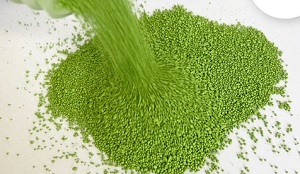Sustainability principles have pushed the development of new additives with improved functional performance. These new materials are contributing greatly to the applications for which they are intended for, such as packaging, infrastructure, construction, automotive and transportation, electronics and healthcare. The benefits they bring to these applications have improved end-products quality, while reducing the impact on the environment.
Eco-friendly colourful option
In 1979, the founders of Holland Colours set to work in an abandoned paper factory in Apeldoorn, the Netherlands. The team worked on an idea that would ultimately impact the world of colour and earn them the name ‘pioneers’. Based on the idea that colouring plastics should be made simpler and cleaner, they developed, in close cooperation with a customer, the concept of ‘highly loaded pigment granules’.
Despite its development years ago, Holcobatch® is more relevant today because Holcobatch® not only offers superior performance PVC and PET colourant but also serves as the frontrunner to the drive to offer eco-friendly PVC and PET colourants. “We have a history of developing products with optimal performance and ease of application”, according to Coen Vinke, CEO of Holland Colours.
In 1979, sustainability wasn’t on most people’s minds and industrial world’s agenda. But, highly concentrated, dust-free Holcobatch® already differed in several significant ways from the colour pigments then used in PVC pipes for the building and construction industry. It was the first colourant product to encapsulate pigments and additives using a renewably sourced carrier instead of a polymer. This was unique at the time – and it remains so today, making Holcobatch® a truly sustainable colourant.

Holcobatch® is also highly pigmented and offers excellent colouring consistency. Thanks to its unique composition, it has a lower melting point than the alternatives. This enables quick colour release, resulting in optimal distribution of the colourant. This means it can be used in low doses, which is another win for the environment. Holcobatch®’s position as the sustainable choice extends to processing, too. Being easy to melt, it only requires little energy to do so. This lowers the carbon footprint during processing at our customers.
Aside from Holcobatch®, other breathrough products from Holland Colours include the highly loaded Holcopearl® and Holcoprill for the packaging and building & construction markets and the highly opaque Holcomer for the dairy PET packaging industry. “Holcomer Circulaire was launched in 2018 as a first-of-its-kind low mineral, highly opaque solution with improved recyclability,” explains Eelco van Hamersveld, CTO of Holland Colours.
Holland Colours’ range of products contains both solid and liquid colouring systems - all designed to answer the challenges that customers need to confront today. Over the years, the company has developed a full palette of standard and customised colourants, including opaque, metallic and frost. In addition to colourants and masterbatches, it offers a wide choice of additives. The products are manufactured in Europe, the Americas and Asia. Holland Colours not only continues to deliver colouring performance across a wide range of polymers, it has always supported the kind of sustainable solutions that will help build a truly circular economy.
FR synergists for wire and cable
TOLSA, a supplier of special additives for the wire and cable, construction, transport, and electronics industries, is set to present its latest advancements in flame retardant additives for the wire and cable market at the Wire 2020 (International Wire and Cable Trade Fair) on 7-11 December in Düsseldorf, Germany. The company will showcase its ADINS® Clay and ADINS® Fireproof range of high-performance flame retardant (FR) synergists which have won strong adoption in the wire and cable industry. TOLSA is working closely with leading wire and cable manufacturers to develop cutting-edge applications for the automotive and electrical/electronics industries.
TOLSA’s ADINS® range of flame-retardant additives are based on a breakthrough technology using natural silicates, offering tailored performance benefits and making it possible to replace part of the high-loaded flame retardant system. “These are unique additives that bring significant performance advantages for halogen and halogen-free flame retardant systems in the wire and cable industry,” said Alberto Francesena, Global Sales Manager for TOLSA’s Special Additives Business unit. “Our FR technology continues to evolve and we see continuing growth for ADINS synergists in a wide range of systems that require the highest standards of flame retardancy. Our materials are highly versatile and can be fine-tuned to meet the high-performance needs of formulators and end users.”

ADINS® Clay and ADINS® Fireproof additives are based on surface-modified silicates. These synergists can be used in combination with several of the commonly used flame retardants, including halogenated, metal hydroxides, and intumescent systems. Furthermore, these products are compatible with a range of polymers including ethylene vinyl acetate (EVA), polyvinyl chloride (PVC), polypropylene (PP), polyethylene (PE), polyamides (PA), rubbers like EPDM, and a variety of coatings. Even at low dosages, ADINS® Clay and ADINS® Fireproof deliver high performance including anti-dripping effect, improved mechanical properties of the char, reduction of heat release, and smoke suppression.
The ADINS® Clay family includes ADINS® Clay 20, ADINS® Clay 80T, and ADINS® Clay Sil1. ADINS® Clay 80T additive has shown strong impact in smoke and heat release and is currently marketed in rubber matrices for cable applications and also in the transport industry including plastic parts for trains. Tolsa has also introduced ADINS® Clay Sil1, which is utilised in silicone and PVC formulations, delivering reduced heat release and smoke suppression. It serves as an effective alternative to antimony trioxide (ATO), thus easing environmental concerns.
ADINS® Fireproof is a ceramifying additive based on a natural silicate and doped with low melting glasses, providing the desired fireproofing effect for a variety of systems. Due to the versatility of the technology, ADINS® Clay and ADINS® Fireproof grades can be tailored to offer an optimum level of functionality to end products, ensuring compliance with the highest requirements, standards, and regulations. They comply with the most stringent international health and safety regulations such as the European Construction Products Regulation (CPR) and the Railway EN45545.














